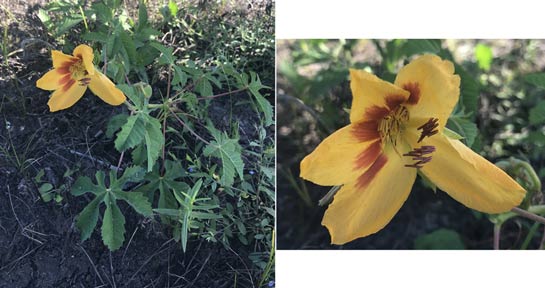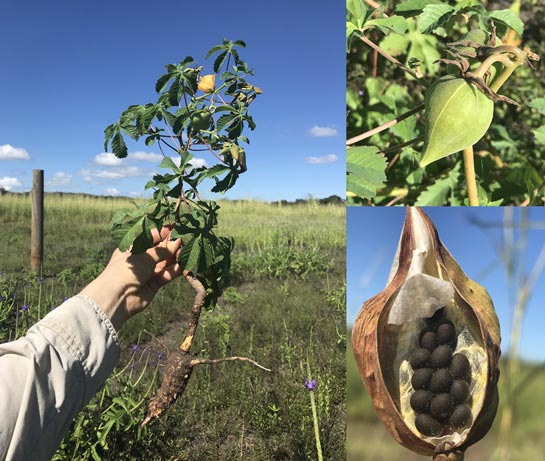 |
QUICK SEARCH
MO PROJECTS:
Africa
Asia/Pacific
Mesoamerica
North America
South America
General Taxonomy
Photo Essays
Training in Latin
America
MO RESEARCH:
Wm. L. Brown Center
Bryology
GIS
Graduate Studies
Research Experiences
for Undergraduates
Imaging Lab
Library
MBG Press
Publications
Climate Change
Catalog Fossil Plants
MO DATABASES:
W³MOST
Image Index
Rare Books
Angiosperm
Phylogeny
Res Botanica
All Databases
INFORMATION:
What's New?
People at MO
Visitor's Guide
Herbarium
Jobs & Fellowships
Symposium
Research Links
Site Map
Search
|
Draft Treatments | Guidelines | Checklist | Citing | Editors The Cutting EdgeVolume XXVI, Number 1, January, 2019News and Notes | Leaps and Bounds | Germane Literature | Season's Pick | Annotate your copy BIXACEAE (or, for some, COCHLOSPERMACEAE). This is not really a new record, more of a rediscovery, an excuse to put up photos, and confirmation that finally we are able to cite specimens of Amoreuxia palmatifida DC. deposited in Costa Rica. Said sp. was first reported from the country more than 15 years ago [see The Cutting Edge 10(4): 3, Oct. 2003], and is still known here only from the vicinity of Bagaces, at Hacienda Monteverde. According to our most recent correspondent on this issue, Manual Aristolochiaceae contributor Esteban Jiménez, this round of forwarded images was initiated by “una señora dueña” of that property, where it grows in apparently rather dense stands at the edge of seasonal ponds. The original Costa Rican collection having been lost or misplaced, A. palmatifida was recollected at Hacienda Monteverde in 2014 by entomologist Gordon W. Frankie (UC), who deposited his material at MO. Now it is also vouchered by two collections deposited in a Costa Rican herbarium: J. E. Jiménez & García 4419 (USJ) and Juárez & García 1623 (USJ).
At least some spp. of Amoreuxia (including A. palmatifida) can have large, starchy roots, which are harvested and form part of the traditional diet in certain communities, e.g., in Mexico (Sinaloa):
https://www.redalyc.org/html/141/14123097011/ Thanks and a tip o' the hat to Esteban for the photos, and to all others involved for their collaboration in making specimens. RUBIACEAE. Well, we told you to be on the lookout for it (in the Manual Rubiaceae family discussion), and darned if it didn't turn up! Oldenlandiopsis callitrichoides (Griseb.) Terrell & W. H. Lewis, widespread in the Neotropics but spottily distributed, is one of those spp. that mysteriously seemed to "skip" Costa Rica, having been recorded from both Nicaragua and Panama. This is a diminutive, cushion-forming herb, on the order of Callitriche terrestris Raf. (Callitrichaceae, or nowadays Plantaginaceae) or some manifestations of Pilea microphylla (L.) Liebm. (Urticaceae), so it stood to reason that its apparent scarcity might be explicable at least in part by its inconspicuousness. That the two last-mentioned spp. both grow in suitable Oldenlandiopsis habitat in Costa Rica has not made our task any easier. Nonetheless, sharp-eyed and indefatigable Manual co-PI Barry Hammel (MO) kept O. callitrichoides in the back of is mind, and was ready when he finally came upon it "where [he] wasn't in the least bit looking for it" (go here to Hammel’s Flickr pages for photos): in downtown San José, in sidewalk cracks in front of the Mexican embassy! Our experience has been that, as soon a one acquires a search image for a particular sp., it starts popping up everywhere... |
© 1995-2025 Missouri Botanical Garden, All Rights Reserved
4344 Shaw Blvd.
St. Louis, MO 63110
(314) 577-5100
Technical Support

